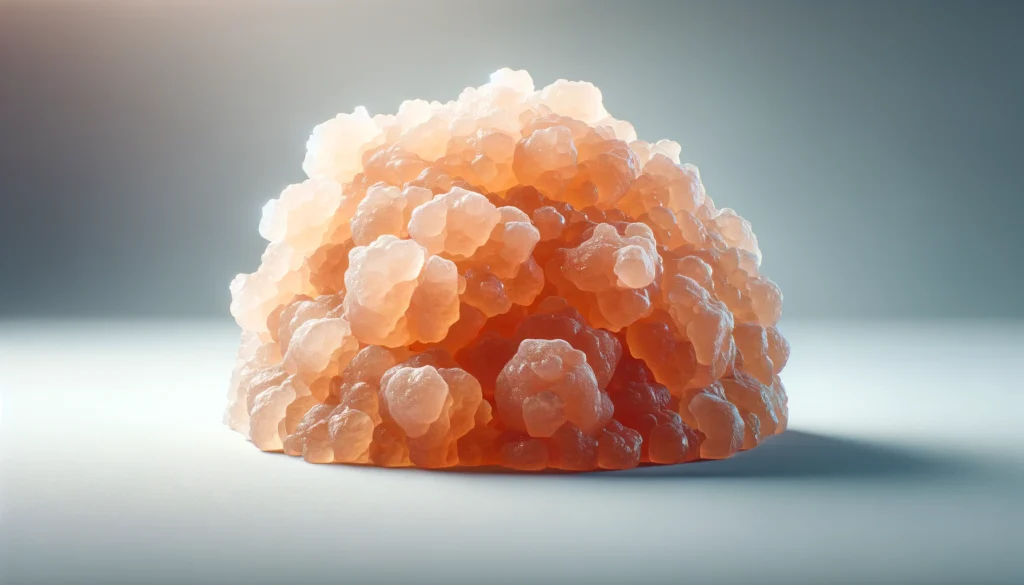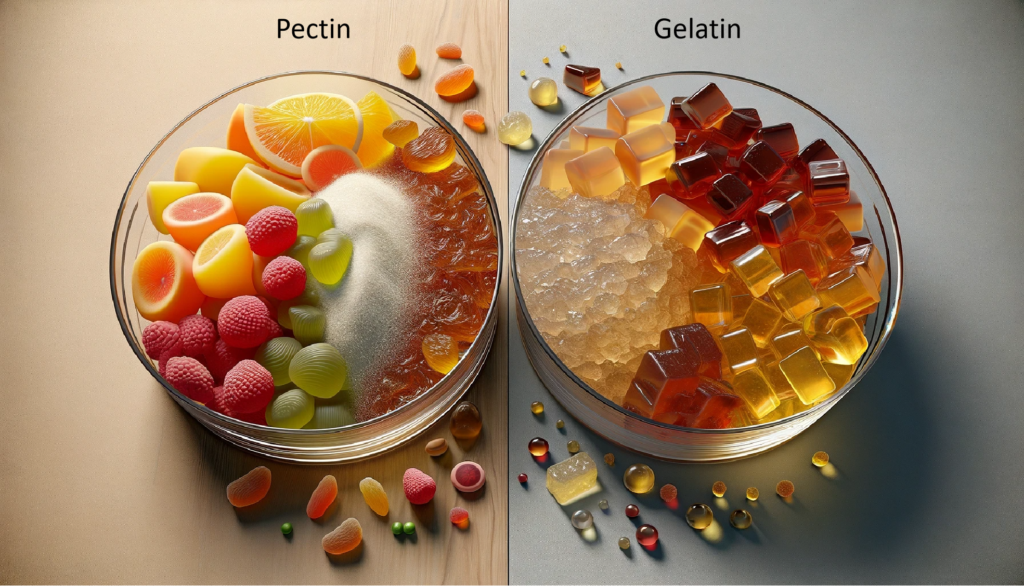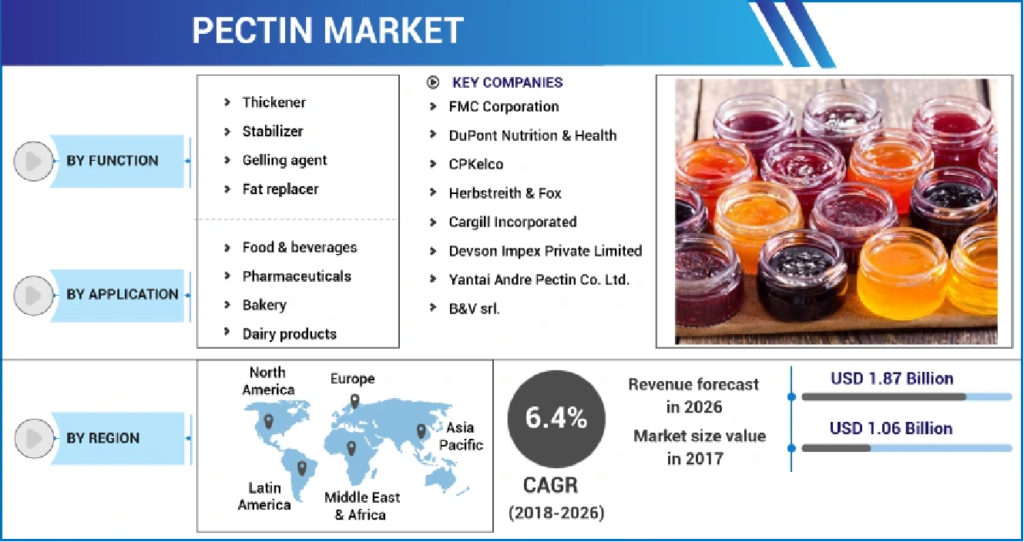In the colorful and delightful world of gummy production, one ingredient plays a pivotal role in creating these popular treats – pectin. This blog aims to shed light on pectin, a natural gelling agent that has revolutionized the gummy industry. From its basic properties to its diverse applications, we will explore why pectin has become a preferred choice for many manufacturers, especially in creating vegan and health-oriented gummy products. Whether you're a consumer curious about the ingredients in your favorite gummies or a manufacturer looking to understand pectin's role in gummy production, this comprehensive guide will provide you with in-depth insights into the world of pectin.
1. What is Pectin?
1.1 Nature's Gelling Agent
Pectin is a naturally occurring polysaccharide found in the cell walls of plants, particularly abundant in fruits such as apples, citrus fruits, and berries. It is extracted through a process involving the use of hot water, acid, and high pressure, which isolates pectin from the plant material.
1.2 Properties and Uses
In its pure form, pectin is a white to light brown powder that is soluble in water. It has the unique ability to form a gel-like structure when dissolved in water and then cooled, which is why it's widely used as a gelling agent in food products. The gelling property of pectin is influenced by factors like pH level, sugar content, and the presence of divalent cations, such as calcium.
1.3 Pectin in the Food Industry
Pectin's role in the food industry extends beyond just gummy production. It is also used in jams, jellies, desserts, and as a stabilizer in dairy products. Its natural origin and gelling properties make it a versatile ingredient for various culinary applications.


2. The Role of Pectin in Gummies Manufacturing
2.1 How Pectin is Used in Gummy Production
A.Pectin's Unique Gelling Mechanism
In gummy production, pectin is prized for its ability to form a gel under specific conditions. The process typically involves dissolving pectin in a sugar and acid solution. This mixture is then heated and cooled to trigger the gelling process. Pectin requires the presence of both sugar and acid to form a stable gel, which is why most pectin-based gummies have a distinct sweet and tangy flavor profile.
B.Tailoring Texture and Firmness
The texture and firmness of the gummies can be adjusted by altering the type of pectin used, the concentration of pectin in the mixture, and the cooking temperature and time. This flexibility allows manufacturers to create gummies with a range of consistencies, from soft and squishy to firm and chewy.
C.Incorporating Flavors and Nutrients
Pectin's mild flavor profile and its ability to gel at lower temperatures make it an excellent medium for incorporating a variety of flavors and nutrients. This is particularly beneficial for health-focused gummies, where the preservation of vitamins, minerals, and other supplements is crucial.


2.2 Comparison with Gelatin
Traditionally, gelatin, derived from animal collagen, has been the go-to gelling agent in gummy production. However, pectin offers a plant-based alternative, aligning with the growing demand for vegan and vegetarian products. Unlike gelatin, which gives a melt-in-the-mouth texture, pectin provides a firmer, more chewy texture. This difference in texture is particularly appealing to consumers who prefer a firmer bite in their gummies.
2.2.1 Advantages of Pectin Over Gelatin
Plant-Based Origin: Pectin is derived from fruits, making it suitable for vegan and vegetarian diets, unlike gelatin, which is animal-based.
Allergen-Free: Pectin poses a lower risk of allergic reactions compared to gelatin, which can be a concern for those with specific allergies.
Acid and Heat Stability: Pectin-based gummies are more stable in acidic conditions and maintain their texture better at varying temperatures.
Clean Label Appeal: Pectin is often perceived as a more natural and health-conscious option, aligning with the clean label trend.
2.2.2 Disadvantages of Pectin Compared to Gelatin
Texture Differences: Pectin tends to create a firmer, chewier texture, which might not be preferred by consumers who enjoy the soft, melt-in-the-mouth texture of gelatin-based gummies.
Complex Formulation: Achieving the desired consistency with pectin can be more challenging, requiring precise control of acidity, sugar content, and pectin type.
Cost Considerations: Pectin can be more expensive than gelatin, potentially impacting the cost-effectiveness of the production process.
2.3 Benefits of Using Pectin in Gummies
Vegan-Friendly: Pectin is derived from plants, making it an ideal ingredient for vegan gummies. Its use caters to the dietary restrictions of vegans and vegetarians, who avoid animal-derived products like gelatin.
Allergen-Free: Pectin is free from common allergens and is generally considered safe for people with food allergies or intolerances, unlike gelatin, which may cause reactions in some individuals.
Clean Label Ingredient: As consumers become more health-conscious, the demand for clean label products has risen. Pectin is perceived as a natural and healthy ingredient, enhancing the appeal of gummies as a health-oriented snack.
Versatility in Flavor and Clarity: Pectin allows for a wide range of flavors and colors. It provides a clear, glossy appearance, which is particularly desirable in fruit-flavored gummies.
Stability in Various Conditions: Pectin-based gummies exhibit excellent stability under different conditions, including varying temperatures and pH levels, making them suitable for a wide range of environments.
Nutrient Preservation: The gelling process with pectin occurs at lower temperatures, which helps in better preservation of heat-sensitive nutrients like vitamins and probiotics often added to health-focused gummies.
3. Types of Pectin and Their Properties
3.1 Understanding Pectin Varieties
Pectin is not a one-size-fits-all ingredient; its various types offer distinct properties that can significantly influence the final product in gummy manufacturing. The two primary categories of pectin are High Methoxyl (HM) Pectin and Low Methoxyl (LM) Pectin, each with unique characteristics.


A. High Methoxyl (HM) Pectin
Characteristics: HM Pectin typically requires a higher sugar content (above 55%) and a certain level of acidity (pH between 2.8 and 3.5) to form a gel. It is extracted under acidic conditions and has a degree of methoxylation above 50%.
Gummy Texture: Gummies made with HM Pectin tend to have a classic, tender, and slightly sticky texture. They are ideal for traditional sweet gummies.
Usage: HM Pectin is commonly used in gummies where a softer gel and a sweet profile are desired.
B. Low Methoxyl (LM) Pectin
Characteristics: LM Pectin can form a gel under a wider range of conditions, including lower sugar concentrations and varying pH levels. It is extracted under less acidic conditions and has a degree of methoxylation below 50%.
Gummy Texture: LM Pectin produces a firmer, less sticky gel compared to HM Pectin. It's often used in gummies that require a more robust structure or are lower in sugar.
Usage: This type of pectin is ideal for dietary and health-focused gummies, especially those with added minerals or vitamins.
C. Amidated Low Methoxyl (ALM) Pectin
Characteristics: ALM Pectin is a modified form of LM Pectin, where some of the methoxyl groups are replaced with amide groups. This modification allows it to gel with lower amounts of acid and calcium.
Gummy Texture: ALM Pectin can create a smooth, spreadable gel, making it suitable for a variety of textures in gummy production.
Usage: It's particularly useful in creating gummies with a creamy texture or those requiring less rigidity.


3.2 Impact on Gummy Texture and Consistency
The choice of pectin type directly impacts the texture and consistency of gummies. HM Pectin is preferred for a classic gummy texture, while LM and ALM Pectins are chosen for their ability to create firmer gels and accommodate different nutritional formulations. The type of pectin also influences the gelling process, setting time, and the overall sensory experience of the gummies.
4. Pectin's Health Benefits
4.1 Nutritional Profile of Pectin
Pectin, primarily known for its use as a gelling agent, also boasts a nutritional profile that contributes to various health benefits. As a natural fiber found in fruits, pectin is rich in soluble dietary fiber. This type of fiber is known for its ability to absorb water and form a gel-like substance in the digestive system.
4.2 Health Benefits of Pectin
4.2.1 Digestive Health
Gut Health: Pectin's soluble fiber content aids in maintaining a healthy digestive tract. It helps regulate bowel movements and can prevent constipation.
Prebiotic Effects: Pectin acts as a prebiotic, feeding the beneficial bacteria in the gut. This supports a healthy gut microbiome, which is crucial for overall digestive health.
Detoxification: The gel-forming property of pectin can also aid in the removal of toxins and waste products from the body, promoting a natural detoxification process.
4.2.2 Cholesterol Management
Lowering Bad Cholesterol: Pectin has been shown to reduce levels of LDL (low-density lipoprotein) cholesterol, often referred to as 'bad' cholesterol. It does this by binding to cholesterol in the gut, preventing its absorption into the bloodstream.
Heart Health: By lowering LDL cholesterol levels, pectin contributes to better heart health and reduces the risk of cardiovascular diseases.
4.2.3 Blood Sugar Regulation
Slowing Glucose Absorption: Pectin can slow down the absorption of glucose (sugar) into the bloodstream. This helps in managing blood sugar levels, particularly beneficial for individuals with diabetes or those at risk.
Appetite Control: The fiber in pectin can also help in controlling appetite by promoting a feeling of fullness, which can aid in weight management.
4.2.4 Additional Health Benefits
Immune Support: Pectin has been linked to immune system support, potentially enhancing the body's ability to fight infections and inflammation.
Cancer Prevention: Some studies suggest that pectin may have a role in preventing certain types of cancer, although more research is needed in this area.
5. Pectin in Dietary and Nutritional Supplements
5.1 Pectin's Growing Popularity in Health-Focused Gummies
The use of pectin extends beyond traditional gummy candies to a rapidly growing segment of health-focused gummies. This shift is driven by the increasing consumer demand for healthier, more natural supplement options. Let’s give two examples of nutritional gummies here:
A. Vitamin Gummies
Enhanced Bioavailability: Pectin-based vitamin gummies have gained popularity for their ability to enhance the bioavailability of vitamins. The natural fiber in pectin aids in the gradual release and absorption of vitamins in the body.
Consumer Appeal: These gummies are particularly appealing to individuals who find swallowing pills challenging. The pleasant taste and chewable form make vitamin intake more enjoyable, encouraging consistent supplement use.
B. Probiotic Gummies
Supporting Gut Health: Probiotic gummies utilize pectin to encapsulate beneficial bacteria, supporting gut health. Pectin's prebiotic properties further enhance the efficacy of these gummies by fostering a healthy gut environment.
Stability and Shelf Life: Pectin provides a stable matrix for probiotics, protecting them from degradation and extending the shelf life of the product.
5.2 Pectin-Based Gummies in Health and Wellness Markets
Natural and Safe: Pectin's natural origin and safety profile make it an attractive ingredient in the health and wellness markets. Consumers increasingly prefer products with clean, understandable ingredient lists, and pectin fits this criterion perfectly.
Versatility in Formulation: The versatility of pectin allows for the creation of gummies catering to various health needs, including immune support, energy boost, sleep aid, and more.
Meeting Dietary Restrictions: Pectin-based gummies are suitable for a wider audience, including those following vegan, vegetarian, and allergen-free diets. This inclusivity broadens their appeal in diverse consumer groups.
Marketing Edge: The use of pectin can be a strong marketing point, aligning with the growing trend towards plant-based and 'free-from' products. Brands can leverage this aspect to attract health-conscious consumers.


6. Challenges and Considerations in Using Pectin
6.1 Navigating Technical Challenges
Formulating gummies with pectin can present several technical challenges that manufacturers need to address:
Achieving the Right Gel Strength: Balancing the pectin concentration, sugar content, and acidity is crucial to achieve the desired gel strength. This requires precise formulation and testing to ensure consistency across batches.
Temperature Sensitivity: Pectin's gelling properties are temperature-dependent. Manufacturers must carefully control the cooking and cooling temperatures to ensure proper gel formation.
pH Level Management: The pH level significantly affects pectin's ability to gel. Maintaining the correct pH level is essential, especially when adding ingredients like fruit juices, which can vary in acidity.
Ingredient Compatibility: Some ingredients may interfere with pectin's gelling ability. For instance, certain enzymes in fresh fruits can break down pectin, affecting the texture of the final product.
6.2 Texture and Flavor Considerations
Creating the perfect pectin-based gummy involves more than just technical precision; it also requires a keen understanding of consumer preferences:
Texture Optimization: The type and amount of pectin used dictate the texture of the gummy, from soft and chewy to firm and bouncy. Finding the right balance to meet consumer expectations is key.
Flavor Masking: While pectin itself is relatively neutral in taste, it can affect the overall flavor profile of the gummies. Masking agents or flavor enhancers may be needed to ensure a palatable end product.
Color and Clarity: Pectin can impact the clarity and vibrancy of colors in gummies. Adjustments in the formulation may be necessary to achieve the desired visual appeal.
7. Sustainability and Ethical Aspects of Pectin
7.1 Pectin's Contribution to Sustainable Food Production
Pectin not only enhances the quality of food products but also aligns with sustainable and ethical production practices:
Natural and Renewable Source: Pectin is derived from fruits, making it a renewable resource. Its extraction from fruit byproducts also contributes to waste reduction in the food industry.
Reduced Environmental Impact: As a plant-based ingredient, pectin has a lower environmental footprint compared to animal-derived alternatives like gelatin, particularly in terms of greenhouse gas emissions and land use.
Supporting Biodiversity: Sourcing pectin from a variety of fruits can support agricultural biodiversity, encouraging the cultivation of different fruit crops.
7.2 Meeting Consumer Demand for Natural Ingredients
The growing consumer demand for natural and environmentally friendly ingredients has brought pectin to the forefront:
Clean Label Appeal: Consumers increasingly seek products with simple, natural ingredients. Pectin's plant-based origin and minimal processing make it a perfect fit for clean label products.
Health and Wellness Focus: With a rising focus on health and wellness, ingredients like pectin that offer nutritional benefits while being sustainably sourced are highly valued.
Ethical Consumerism: The use of pectin aligns with the ethical considerations of many consumers, particularly those concerned with animal welfare and environmental sustainability.
8. Innovations and Future Trends in Pectin Use
8.1 Emerging Trends in Pectin Applications
The world of pectin is continuously evolving, with new applications and innovations emerging:
Enhanced Functional Gummies: There's a growing trend towards developing functional gummies with added health benefits, such as energy-boosting, sleep-inducing, or stress-reducing properties. Pectin's versatility makes it an ideal carrier for these functional ingredients.
Tailored Textures and Flavors: Advances in pectin formulation are enabling manufacturers to create gummies with more diverse textures and flavors, catering to a broader range of consumer preferences.
Pectin in Plant-Based Alternatives: As the plant-based food market expands, pectin is being explored as a key ingredient in vegan alternatives to dairy and meat products, thanks to its gelling and texturizing properties.
8.2 Future Prospects in Gummy Production and Beyond
Looking ahead, pectin's role in gummy production and other food products is set to grow:
Innovative Health and Wellness Products: The health and wellness sector will likely see an increase in innovative products utilizing pectin, especially in areas like gut health, immunity, and personalized nutrition.
Sustainable Packaging Solutions: Research into pectin's potential in biodegradable and edible packaging solutions is gaining momentum, offering an eco-friendly alternative to traditional packaging materials.
Global Market Expansion: As consumer awareness of pectin's benefits grows, its use is expected to expand globally, particularly in markets where plant-based and clean label products are in high demand.
Conclusion
In conclusion, pectin's journey from a humble gelling agent to a key player in the food industry, particularly in gummy production, is a testament to its versatility, health benefits, and alignment with current consumer trends. As we have explored, pectin offers a multitude of advantages, from its role in creating diverse and appealing textures in gummies to its contribution to health and wellness. The future of pectin looks bright, with innovations and trends pointing towards its increased use in functional foods, sustainable solutions, and global market expansion. Pectin's story is one of continuous evolution, and its potential in the food industry is bound only by the limits of our creativity and innovation.
References:



3 Responses